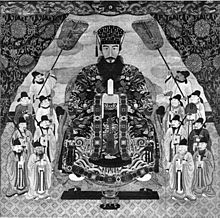Ogoe

Ogoe (御後絵, Okinawan: ugui) are posthumous Okinawan portraits. Although it is unknown when the tradition of portraiture first began in the area, Ryukyu developed a unique style during the 15th-19th centuries.
Ogoe were all painted in similar style; they all place the king in the center surrounded by high officials and other retainers, with the king much larger than the others to emphasize his power and authority.[1]
In the past the portraits were painted directly onto the walls of the Enkaku-ji Buddhist Temple in Okinawa as murals but it is believed that owing to damage caused by fires to the temple, in 1717 the court artist to the Ryukyu Kingdom, Soki Yamaguchi, converted all the portraits to wall hung scrolls or kakejiku.[2]
After the Ryukyu Kingdom collapsed, copies of the ogoe were kept at Nakagusuku-udun Palace. Ten of them were photographed by Yoshitaro Kamakura in 1924 or 1925.[3] In the same time, Majikina Ankō also came to Nakagusuku-udun to research these portraits.[4]
During the 1945 Battle of Okinawa, eight employees of Nakagusuku-udun palace, including Maehira Bōkei (真栄平 房敬), put the antiquities in boxes and hid them in a gutter on the palace grounds. When the battle came to end and the Shuri castle was captured by the U.S. Army, Maehira came back to Nakagusuku-udun, found that the palace had burned to the ground and that all the boxes they had hidden were empty.[5] Maehira thought that these ogoe most likely survived and were carried off.[6][7]
These lost antiquities included the royal crowns, Omoro Sōshi, ogoe, and others. Omoro Sōshi was discovered in the United States a few years later, and returned to Okinawa in 1953; other antiquities were still not found. Since 2000, these lost 11 artifacts, including crowns, hibenfuku (皮弁服, ceremonial vestments worn by Ryukyuan kings), and ogoe, were listed in FBI National Stolen Art File.[8][9]
In March 2024, the portraits of Shō Kei and Shō Iku, along with twenty other cultural artifacts, were discovered in the United States and returned to Okinawa Prefecture.[10]
References[edit]
- ^ "御後絵 (おごえ)" [After-life painting (Ogoe)]. ryukyushimpo.jp (in Japanese). March 2003. Retrieved 2018-12-06.
- ^ "Shurijo Castle Park Exhibition. King's Portraits (Ogoe)" (PDF). oki-park.jp. Retrieved 2018-12-06.
- ^ "Where were the Ogoe paintings?".
- ^ 御後絵とその形式について, pp.48-50
- ^ 琉球の肖像画の研究, pp.33
- ^ 琉球の肖像画の研究, pp.30-34
- ^ 沖縄戦で流出した旧王家の宝物
- ^ 米国所在の沖縄コレクションの移動の背景 (in Japanese). 23 January 2008.
- ^ Federal Bureau of Investigation. "National Stolen Art File". (please input keyword: "Crown of the Sho Royal Family of the Ryukyu Kingdom", "Chinese-Style Ceremonial Costume of King (Hibenhuku)", "Portrait of King Shoen", "Portrait of King Shoshin", "Portrait of King Shogen", "Portrait of King Shonei", "Portrait of Prince Shojun", "Portrait of King Shoiku", "Portrait of King Shokou", "Portrait of King Shohou", "Portrait of King Shotei", "Portrait of King Shokei" or "Portrait of King Shoboku")
- ^ "琉球王国の国王の肖像画 アメリカで見つかる 沖縄県に引き渡し" [Ryukyu Kingdom Royal Portraits Discovered in America, Returned to Okinawa Prefecture]. www.nhk.or.jp/ (in Japanese). Retrieved 2024-03-15.
